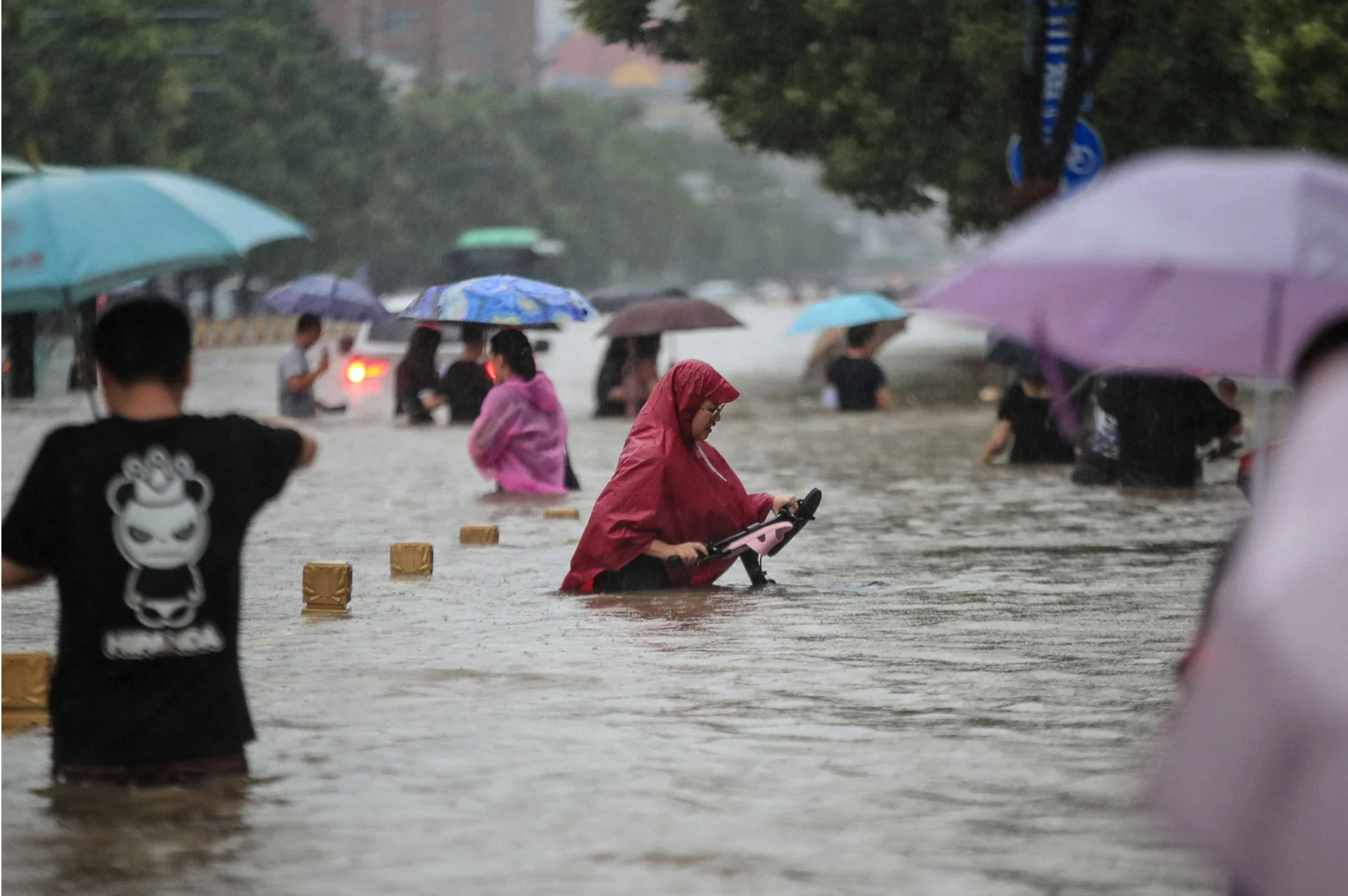
The camera scans across a crowd of people in the dark under flashing blue light, almost like a club. There is no sound but the murmur of conversation, and there is brown water up to everyone’s shoulders. It hits you when you see the metal poles and the plastic hand-straps: This is a subway train, and its riders have about 18 inches of air to go before they drown.

That was one of many horrifying scenes this week in Zhengzhou, a Los Angeles–sized metropolis in Eastern China that became the latest victim of flash floods juiced by an atmosphere more dense with carbon dioxide than at any time in the last 4 million years.
Twelve people drowned in Zhengzhou’s flooded subway; hundreds more escaped along the sides of tunnels in which the rails had been swallowed by rapids. Between Saturday and Tuesday, according to Chinese weather statistics reported by Reuters, Zhengzhou saw more than 24 inches of rain—almost as much in three days as is typical for an entire year there. Dozens are dead; 100,000 people have been evacuated. It was a storm to be expected once in a thousand years, the Zhengzhou weather bureau said.
Expectations are changing. On Thursday morning, Zhengzhou was the third rainfall-flooding disaster to make the front page of the Wall Street Journal in seven days. There was also a 500-year flood that demolished towns in Western Germany. And that followed major summer flooding in cities like New York, Detroit, and Chicago. New Orleans is on pace to have its rainiest year ever.
Is this normal? On the one hand, we’re living in a time of unprecedented documentation. Never before have we had access to such high-quality, quickly disseminated photos and videos from scenes of calamity that would once have been relegated to a dry sentence in a wire report—if they were reported at all. There’s barely a national record of flood damage here in the U.S., where much of it goes unreported, let alone a global one.
On the other hand, things are different this year, because—at the very least—we are one more year into a giant atmospheric experiment to pump the sky full of greenhouse gases.
Amid the various signs that the climate crisis is picking up steam, it’s worth paying special attention to the epidemic of rainfall flooding, which has a unique role in the vanguard of climate-change disasters. Rainfall flooding can happen anywhere, it can happen with little warning, and it is all but impossible to head off once underway.
It’s scary in another way, too. Cities have grown to feel like resilient places in the face of disaster. In a plague, the city has more doctors and more hospital beds. Its fire risk is lower than ever, while some fire-prone rural areas approach uninsurable status. In a windstorm, the city’s power lines are buried. In a heat wave, its cooling centers are nearby. When it comes to adapting to new threats, densely populated areas find it easier to raise money for public improvements, which in turn protect larger numbers of people for less money. A great city’s exposure to risk is surpassed only by its power to respond.
But cities may not be so resilient when it comes to an epidemic of once-in-a-thousand-year rainstorms. Instead, watching Zhengzhou residents prepare to drown on their way home from work, I had the feeling that supercharged rainstorms recall the defeatist defensive strategy of the nuclear era: If you can’t stop the bomb, you could at least try not to all be in one place when it lands. That’s about the best you can do for the rain, too.
My introduction to the subject was a trio of historically unlikely storms in Houston, which culminated in the rainfall from Hurricane Harvey in 2017. Part of the problem for Houston, and for all cities, is how much pavement there is. Water pools and runs off not according to FEMA’s flood maps, but according to a hidden manmade cartography of parking lots, lawns, drains, sewer diameters, and gullies. It goes where it goes and we can’t stop it.
Houston is trying to adapt. One year after Harvey, Harris County voters approved the largest local bond issue in the history of Texas to build flood infrastructure; developers are now required to practice a kind of “leave no trace” policy when it comes to rainfall—once it’s been developed, a site should not send one more drop downstream than it did before. As a result, alongside Houston’s ubiquitous parking lots, many new projects feature grassy flood pits.
Will it work? Consider another city that was once thought to have the worst urban flooding problem in the United States: Chicago. The history of Chicago is 150 years of escaping from the muck, and the most recent example of that ingenuity is the Deep Tunnel—109 miles of subway-size concrete tubes deep beneath the metropolis, designed to “bottle rainstorms.”
Bottling rainstorms seems like an awfully good idea right this moment, and cities from St. Louis to London to Hong Kong have emulated the deep-tunnel approach. Unfortunately, Chicago still finds itself playing catch-up against the stronger, more frequent storms noted in the 2014 National Climate Assessment. Other cities have tried to replace pavement with plants, to help soak up the rain. An urban-flooding event now occurs in the U.S. about once every two or three days, according to a recent study of National Weather Service data. Our 20th-century infrastructure simply isn’t up to handling 21st-century rainstorms.
Neither approach seems likely to reach the scale to confront the kinds of rainstorms that hit Houston during Harvey or Zhengzhou last week. Economically, in many places, it might not even make sense to try. Unlike the familiar targets of sea-level rise, adapting for a once-in-a-millennium rainstorm is like buying body armor for Russian Roulette: an expensive solution that won’t even protect you from the unlikely event you were trying to prepare for. Even within metro areas, rainfall flooding hits unevenly, with some neighborhoods inundated while others are sunny and dry.
Not that anyone is any better prepared in the countryside—not in rural Louisiana, nor in the small towns of Bavaria, nor in Ellicott City, Maryland, whose Main Street was submerged in 2018. But, taking a bird’s eye view, at least fewer people live there.
In big cities, meanwhile, it’s not just that asphalt gathers and channels floodwaters, worsening each flooding event before the deep tunnels and rain gardens can get to work. It’s also that the very concentration of critical infrastructure that ensures resilience to other calamities is vulnerable to the random strikes of rainfall flooding. On the whole, the path of resilience still points toward cities. But you might want an umbrella—and some rain boots.